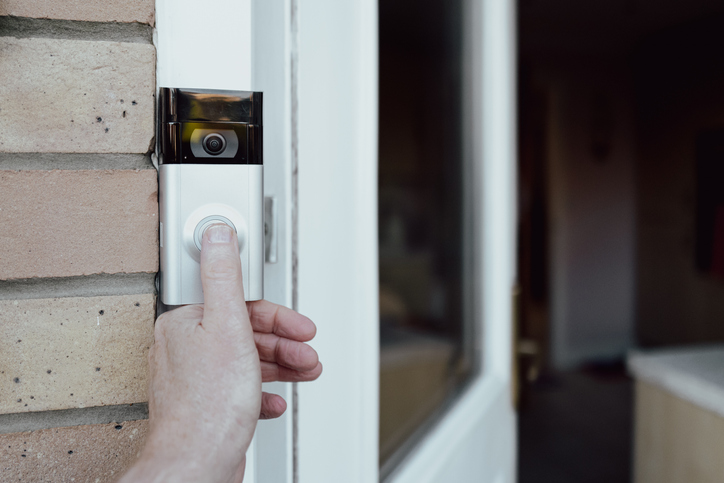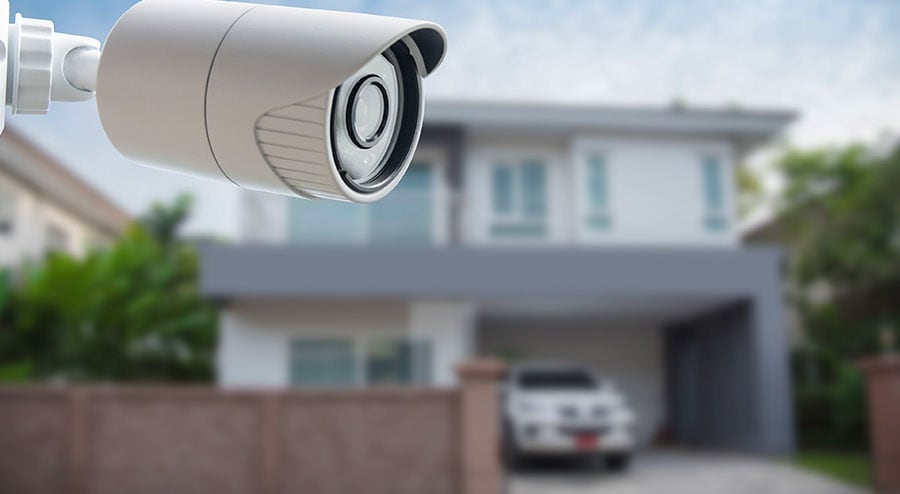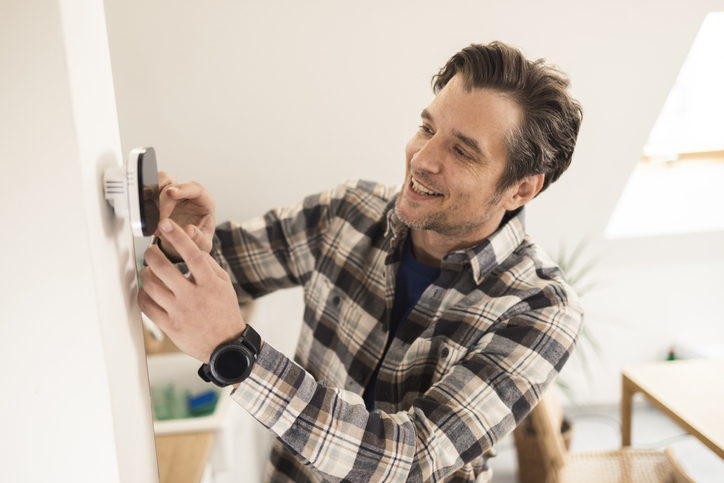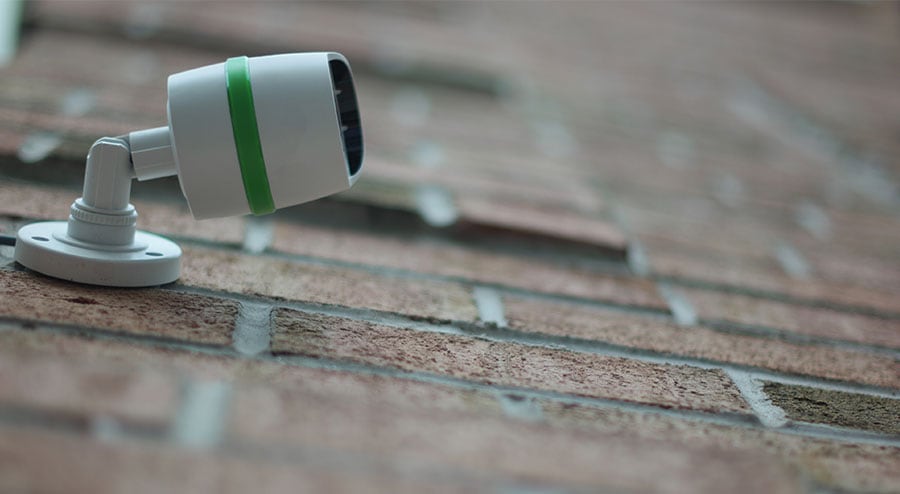In an increasingly connected world, doorbell cameras have emerged as a revolutionary solution for homeowners seeking to enhance security and monitor activities at their doorstep. These innovative devices offer real-time monitoring of visitors and package deliveries, empowering homeowners with convenience, peace of mind, and improved control over their home’s security. With advanced features such as motion detection, two-way communication, night vision, and cloud storage options, doorbell cameras provide an effective and accessible means of ensuring safety and protection for homes and residents alike.

How Doorbell Cameras Work
Doorbell cameras, also known as video doorbell cameras, are innovative home security devices designed to enhance safety and monitoring at the doorstep. Unlike traditional doorbells, these smart devices come equipped with a built-in camera that enables users to see and interact with visitors in real-time. When someone presses the doorbell button or triggers the motion detection feature, the camera activates, capturing live video footage of the area in front of the door.
The camera’s video feed is usually displayed on a compatible device within the home, such as a smartphone, tablet, or smart display. Some doorbell cameras even have a dedicated monitor for this purpose. This real-time feed allows homeowners to quickly assess who is at their doorstep before deciding to answer the door or communicate with the visitor remotely.
Doorbell cameras employ a combination of advanced technologies to ensure smooth functioning and seamless communication. These technologies may include high-definition cameras, wide-angle lenses, infrared sensors for night vision, and two-way audio communication systems. The HD cameras and wide-angle lenses provide clear and wide coverage of the doorstep area, while the infrared sensors enable visibility in low-light or nighttime conditions.
Integration With Smartphones For Remote Monitoring Convenience
One of the most significant advantages of modern doorbell cameras is their seamless integration with smartphones and other smart devices. This integration allows homeowners to remotely monitor their doorstep even when they are not at home.
Through dedicated mobile apps provided by doorbell camera manufacturers, users can access the live video feed and receive instant notifications whenever someone approaches their doorstep. These notifications are triggered by the camera’s motion detection feature, alerting homeowners to potential visitors, package deliveries, or any suspicious activities.
By using the smartphone app, homeowners can view the video feed, listen to audio, and engage in two-way communication with the visitor, regardless of their physical location. This remote monitoring capability adds an extra layer of security and convenience, as it enables homeowners to monitor their home while at work, on vacation, or simply away for a short errand.
The integration with smartphones also allows users to review past recordings, check for missed visitors, or monitor package deliveries. Some doorbell cameras offer cloud storage options, where video clips and recordings are securely stored online, ensuring that important footage is not lost even if the camera is tampered with or stolen.
In just the past year, robbery has increased by 13%, larceny by 20%, motor vehicle thefts by 21%, and residential and nonresidential burglaries by 6% and 8%, respectively
Key Features For Effective Doorbell Cameras
One of the most crucial features of an effective doorbell camera is its motion detection capability. Doorbell cameras equipped with motion sensors can detect movement within a specified range in front of the door. When motion is detected, the camera activates, capturing a video clip or initiating a live video feed. Homeowners receive instant alerts on their smartphones or other connected devices, notifying them of the detected activity.
Motion detection serves as a valuable security alert system, allowing homeowners to be aware of any approaching visitors, potential intruders, or package deliveries. It acts as a proactive measure, providing an early warning to homeowners about activity at their doorstep, even before someone presses the doorbell. Some doorbell cameras allow users to customize motion detection sensitivity and zones, reducing false alerts caused by passing vehicles or nearby movements.
Two-Way Communication To Interact With Visitors At The Doorstep
Two-way communication is another essential feature that sets doorbell cameras apart from traditional doorbells. This feature enables homeowners to have real-time, two-way audio conversations with visitors at the doorstep, regardless of their physical location. When a visitor rings the doorbell or triggers the motion detection, the homeowner receives an alert and can access the live video feed. They can then use the built-in microphone and speaker to communicate with the visitor through the smartphone app or connected device.
This capability offers numerous benefits, such as the ability to communicate with delivery personnel, provide instructions for leaving packages, or even deter potential intruders by giving the impression that someone is home. It also allows homeowners to interact with friends, family, or unexpected visitors, providing a sense of connectedness and security.
Night Vision For Clear Monitoring In Low-Light Conditions
Night vision is a critical feature for doorbell cameras to ensure clear monitoring even in low-light or nighttime conditions. Traditional surveillance cameras often struggle to capture usable footage in the dark, making them less effective during crucial hours when security is most needed. However, doorbell cameras with night vision use infrared (IR) LEDs to illuminate the area in front of the door, providing black-and-white or grayscale images with sufficient detail.
By leveraging night vision capabilities, doorbell cameras can detect and record activities at the doorstep during the night, offering uninterrupted security coverage 24/7. This is particularly useful for identifying potential threats, monitoring package deliveries during late hours, or simply observing nocturnal wildlife around the property.
Weatherproof And Durable Construction For Outdoor Usage
Outdoor doorbell cameras must withstand various environmental conditions, making weatherproof and durable construction a vital feature. These cameras are exposed to rain, snow, dust, and temperature fluctuations, and they need to endure such elements without compromising their functionality.
Manufacturers design weatherproof doorbell cameras with sealed enclosures and waterproofing measures to protect the internal components from moisture and debris. Additionally, they use robust materials like metal or sturdy plastics to ensure the camera’s durability and resistance to impact.
A weatherproof and durable doorbell camera will provide reliable performance throughout different seasons, ensuring constant protection for the home and its occupants. Homeowners can have peace of mind knowing that their doorbell camera can continue to function optimally, even in challenging weather conditions.
Privacy Concerns And Legal Considerations
Doorbell cameras, while providing enhanced security and peace of mind for homeowners, also raise legitimate concerns about privacy rights for those visiting the property, including delivery personnel and guests. As these cameras capture video and audio recordings of individuals who approach the doorstep, it becomes crucial for homeowners to address these potential privacy issues responsibly.
To mitigate privacy concerns, homeowners should take proactive measures. First and foremost, prominently displaying signs or stickers indicating the presence of surveillance cameras at the property’s entrance acts as a form of notice to visitors. This not only informs them about the camera’s presence but also serves as a deterrent against unwanted activities.
Open communication is vital when using doorbell cameras for commercial purposes, such as monitoring delivery personnel or service providers. Homeowners should inform individuals about the presence of cameras and, if required by local laws, obtain their consent before recording them.
It is essential to position the doorbell camera thoughtfully, ensuring that it captures video footage limited to public areas like the doorstep. This way, homeowners avoid infringing on the privacy of neighboring properties or recording activities beyond the intended scope.
Some advanced doorbell cameras offer features like privacy zones, which allow homeowners to mask specific areas within the camera’s view. This feature proves useful in excluding sensitive spots, like windows of neighboring homes, from being recorded, further safeguarding privacy.
Staying informed about local laws and regulations is paramount. Familiarizing themselves with data protection and privacy laws governing the use of surveillance cameras on residential properties helps homeowners comply with legal requirements. Additionally, understanding the rules regarding data retention ensures that video footage is not stored beyond the permitted duration.
Legal Considerations, Consent, And Relevant Regulations Of Doorbell Cameras
When using doorbell cameras for home security, homeowners must navigate various legal considerations to ensure compliance with relevant laws and regulations. One critical aspect is obtaining consent from individuals whose activities may be captured by the camera. In some jurisdictions, recording audio conversations may require the consent of all parties involved, making it crucial for homeowners to understand their local laws concerning audio recording and act accordingly.
Data protection and privacy laws also play a significant role in the use of doorbell cameras. These laws dictate how personal data, including video recordings, should be collected, stored, and used. Homeowners must be aware of their obligations in safeguarding recorded data and ensuring it is not misused or shared without proper authorization.
Moreover, data retention policies are important to consider. Some regions impose specific limits on how long video footage can be stored. Homeowners must comply with these regulations to avoid potential legal consequences arising from exceeding the permitted data retention period.
Furthermore, sharing video recordings should be done with caution. Unauthorized sharing of footage, especially in public forums or social media, may violate privacy laws and lead to legal repercussions.
To further enhance legal compliance, some jurisdictions require homeowners to display legal notices on their property, informing visitors and passersby that video surveillance is in operation. These notices help establish transparency and inform individuals about the presence of cameras, reinforcing their right to privacy.
Recording And Data Storage
Doorbell cameras are equipped with video recording capabilities that allow them to capture and store video footage of various events at the doorstep. When triggered by either the doorbell button press or the motion detection feature, the camera starts recording the activity in front of the door. This recorded video can be in the form of short video clips or continuous footage, depending on the camera’s settings and the length of the event.
The video recording capabilities of doorbell cameras are typically accompanied by high-definition (HD) resolution, which ensures clear and detailed footage. The resolution is essential for identifying faces, reading license plates, or observing other critical details in case of suspicious activities or package deliveries.
Some doorbell cameras offer additional features to enhance the recording process. For example, they may include pre-buffering, where a few seconds of video before the motion trigger or doorbell press are also recorded. This ensures that no crucial moments are missed, as the camera captures what happened just before the trigger event.
Doorbell cameras with onboard storage options use internal memory to store recorded video footage. The available storage capacity varies among different models, and homeowners may need to periodically check and manage the storage to avoid overwriting important recordings.
Cloud Storage Options
One of the significant advancements in doorbell camera technology is the integration of cloud storage options, which provides homeowners with a convenient and secure method of saving video clips and recordings. Unlike relying solely on the camera’s internal storage, cloud storage offers extended capacity and ensures that recorded footage is safeguarded even if the camera is compromised or damaged.
By subscribing to cloud storage services provided by the doorbell camera manufacturer, homeowners gain access to various storage plans tailored to their needs. These plans come with different levels of storage capacity and duration for retaining video recordings. This flexibility allows homeowners to choose a plan that suits their requirements, whether they need more extended storage for continuous recording or a smaller plan for occasional access to past footage.
A primary advantage of cloud storage is the peace of mind it offers through secure data backup. Video clips and recordings are stored in remote servers operated by the service provider, protected by robust encryption and security measures. This ensures that recorded data remains safe and accessible only to authorized users, even if the physical camera is tampered with or stolen.
The accessibility of cloud-stored recordings is another valuable feature. Homeowners can access their video clips and recordings from any internet-connected device, such as a smartphone, tablet, or computer. This remote access allows them to review past events, check for package deliveries, or monitor any suspicious activities in real time, even while away from home.
Cloud storage simplifies the process of sharing video footage when needed. In case of incidents requiring law enforcement involvement or sharing with relevant parties, homeowners can easily retrieve and share the recorded content from their cloud storage account. This streamlines the sharing process, aiding investigations and providing crucial evidence when necessary.
Though cloud storage often requires a subscription fee, the advantages it offers in terms of security, accessibility, and convenience make it a worthwhile investment for many homeowners. By leveraging cloud storage options, doorbell cameras become even more effective in enhancing home security and providing homeowners with the peace of mind they seek.
Popular Brands And Models
In today’s expanding market of doorbell cameras, numerous well-known brands offer an array of models with diverse features and functionalities. Among these top brands, Ring stands out as a pioneer in the industry, providing options such as the Ring Video Doorbell 4, priced at approximately $199, and the Ring Video Doorbell Pro, priced at around $249. Both models offer 1080p HD video, motion detection, and two-way communication, with the Pro version offering additional customization for motion detection and interchangeable faceplates.
Another prominent player is Nest, a subsidiary of Google, offering the Nest Hello doorbell camera at a price of approximately $229. It delivers continuous 24/7 live streaming in 1600 x 1200 resolution, along with advanced features like facial recognition and pre-recorded quick responses.
For those seeking high-quality video resolution, Arlo offers the Arlo Video Doorbell, priced around $149, with 2K HDR video, a 180-degree viewing angle, and reliable motion detection. Alternatively, the Arlo Essential Wire-Free Video Doorbell, priced at approximately $199, provides the same features in a wire-free design for added convenience.
Eufy Security presents an appealing option with its Video Doorbell priced at around $159. This model offers 2K resolution, AI-based human detection, and local storage for video recordings, eliminating the need for monthly fees.
August’s Doorbell Cam Pro, priced at approximately $199, comes equipped with HindSight pre-buffering, two-way audio, and seamless integration with smart locks to create a comprehensive home security system.
SimpliSafe’s Video Doorbell Pro, priced around $169, features dual-sensor motion detection, two-way audio, and compatibility with SimpliSafe’s home security system.
For budget-conscious buyers, RemoBell S, priced at around $99, provides a cost-effective option with HD video, motion detection, and cloud storage for recorded clips. SkyBell’s HD Video Doorbell, priced at approximately $199, offers full-color night vision, free cloud storage for video clips, and multiple-user access, making it an appealing choice for some homeowners.
Comparison Of Features And Functionalities
When comparing the various doorbell camera brands and models, it becomes evident that each offers a distinct set of features and functionalities to cater to different user preferences and needs.
For those seeking excellent video quality, options like Nest Hello and Arlo’s Video Doorbell, both offering 2K resolution, stand out as suitable choices. On the other hand, Ring’s Video Doorbell series and Eufy Security Video Doorbell provide high-definition (HD) video at 1080p, which still offers crisp and clear footage for most users.
Motion detection is a crucial aspect of doorbell cameras, and brands like Ring and Nest Hello excel in this regard. Both offer advanced motion detection capabilities with customizable motion zones, allowing users to fine-tune their camera’s sensitivity and focus on specific areas for alerts.
Two-way audio is a common feature among doorbell cameras, enabling homeowners to communicate with visitors at their doorstep. Models like Ring Video Doorbell Pro, Nest Hello, and Arlo Video Doorbell provide clear and reliable two-way audio communication, allowing users to interact with delivery personnel or deter potential intruders.
Cloud storage is a critical consideration for users who want to save and access recorded video clips remotely. Brands like Ring, Arlo, and Nest Hello offer cloud storage options with subscription plans, ensuring that valuable footage is securely stored and easily retrievable when needed.
For users who prefer local storage options without monthly fees, Eufy Security and SkyBell offer built-in storage solutions for recorded videos. This allows homeowners to keep their data on the device itself or utilize additional storage options like microSD cards.
Some models, like Nest Hello, take doorbell cameras to the next level by incorporating facial recognition technology. This innovative feature allows the camera to recognize familiar faces, providing personalized alerts and enhancing the overall security experience.
Night vision is crucial for doorbell cameras, as it ensures clear monitoring even in low-light conditions. Arlo and SkyBell’s doorbell cameras offer full-color night vision, providing a more detailed and colorful view of the surroundings, while most other brands provide standard black-and-white night vision.
Backup Power And Data Security
Doorbell cameras are designed to provide continuous monitoring and security, even during power outages. To ensure uninterrupted functionality, many doorbell cameras come equipped with backup power sources.
The most common backup power source for doorbell cameras is a built-in rechargeable battery. When the camera’s primary power source, typically the existing doorbell wiring or a connected power adapter, experiences a power outage, the camera seamlessly switches to battery power. This backup battery allows the camera to continue recording video, detecting motion, and providing alerts to homeowners.
The duration of backup power can vary depending on factors such as the camera’s battery capacity, usage patterns, and the frequency of events that trigger the camera. Some models may have batteries that last a few hours, while others can provide backup power for several days.
In addition to battery backup, some doorbell camera models offer optional solar panels as an additional power source. These solar panels can continuously charge the camera’s battery during daylight hours, providing extended backup power and reducing the need for frequent battery recharging.
It’s essential for homeowners to check the specifications of their chosen doorbell camera to understand the extent of its backup power capabilities. Regularly monitoring the battery level and ensuring that the backup power source is functioning optimally is crucial for continuous security coverage during power outages.
How To Prevent Unauthorized Access
Data security is a paramount concern for doorbell cameras, as they capture and store sensitive information about homes and their occupants. To ensure the protection of user data and prevent unauthorized access, reputable manufacturers employ a variety of robust security measures.
Data transmitted between the doorbell camera and connected devices, such as smartphones or tablets, is encrypted. This encryption ensures that any data exchanged remains secure and cannot be intercepted by malicious parties attempting to gain unauthorized access.
Manufacturers also prioritize secure authentication mechanisms. Users are required to create strong passwords or use biometric authentication methods, adding an extra layer of protection to the camera’s app or interface. Additionally, many doorbell camera apps now support two-factor authentication (2FA), where users must enter a verification code sent to their registered email or phone number to access the app.
Data encryption at rest is another vital aspect of data security. Video recordings and other sensitive information stored on the camera or in the cloud are encrypted, rendering them unreadable without the appropriate decryption keys. This way, even if the physical camera is stolen or subject to cyberattacks, the data remains safeguarded.
Regular firmware updates play a crucial role in maintaining data security. Manufacturers release updates periodically to address security vulnerabilities and ensure that the doorbell camera’s software remains up-to-date and protected against potential threats.
Access to user data is typically restricted to essential personnel and services required for maintaining the camera’s functionality and providing customer support. Manufacturers take measures to limit access to sensitive data, ensuring that it is only available to those with proper authorization.
Some manufacturers go the extra mile and subject their security practices to third-party audits and certifications. This demonstrates their commitment to data protection and privacy, providing users with additional reassurance regarding the integrity of the data security measures implemented.
Integrating Doorbell Cameras In Apartments And Rental Properties
Integrating doorbell cameras in apartments and rental properties offers a compelling solution to enhance security and convenience for both tenants and property owners. While feasible, this integration requires careful consideration of shared spaces, privacy concerns, and compliance with property rules and regulations to ensure a harmonious living environment.
Using Doorbell Cameras In Shared Entrances And Rental Properties
Integrating doorbell cameras in shared entrances, such as apartment complexes or rental properties, is indeed feasible and can offer valuable security benefits to both tenants and property owners. However, several factors need consideration to ensure successful implementation.
Landlord Approval
In rental properties, obtaining the landlord’s approval is crucial before installing any security devices, including doorbell cameras. Some landlords may already have security measures in place or may have specific requirements for the type of cameras allowed.
Shared Entrances
In shared entrances like apartment buildings, tenants may need to come to a consensus regarding the installation and usage of doorbell cameras. Open communication and mutual agreement among residents help maintain a harmonious living environment.
Power Source And Wiring
Depending on the doorbell camera model chosen, there might be a need for a power source and wiring. Some models operate on existing doorbell wiring, while others may require a power adapter or have battery-operated options.
Wi-Fi Connectivity
Doorbell cameras need a stable internet connection to function correctly. In apartments or rental properties, the Wi-Fi coverage and signal strength should be sufficient to ensure smooth operation.
Data Privacy And Sharing
Shared entrances raise privacy concerns, as the doorbell camera may capture not only the tenant’s doorstep but also common areas and neighboring units. It is essential to discuss and agree on data sharing and privacy policies to respect each tenant’s rights.
Restrictions Or Modifications Required For Rental Setups
Integrating doorbell cameras in shared entrances and rental properties may necessitate specific restrictions or modifications to align with property regulations and uphold tenant agreements.
Tenants should familiarize themselves with property rules and regulations regarding security installations, as some properties may have restrictions on modifications that tenants can make. To ensure non-damaging installations, tenants can explore doorbell camera models with adhesive mounts or over-the-door brackets, which allow for easy removal without leaving any permanent fixtures.
Considering the privacy of shared entrances, it is crucial to opt for doorbell cameras that offer adjustable fields of view, enabling tenants to limit the camera’s capture to their individual doorstep area and avoid capturing neighboring units or common spaces. This ensures that the privacy rights of other tenants are respected and maintained.
Temporary or wireless doorbell camera options are also worth exploring in rental properties, as they offer a convenient solution that can be easily moved to a new residence without any lasting impact on the property. Tenants may discuss the possibility of using their security deposit to cover any repairs required upon the removal of the doorbell camera, ensuring transparent communication with the landlord.
Moreover, understanding local laws and regulations is essential to comply with data privacy laws and adhere to any legal requirements related to security camera usage in shared spaces and rental properties. This includes informing residents and visitors about the presence of surveillance cameras, if required by local laws, to maintain transparency and respect individual privacy rights.
Conclusion
Doorbell cameras have become an invaluable addition to modern home security systems, providing homeowners with the ability to monitor visitors and packages at their doorstep in real-time. With features like motion detection, two-way communication, night vision, and cloud storage options, these cameras offer convenience, peace of mind, and enhanced security. Despite the privacy and legal considerations that come with their use, responsible implementation and adherence to regulations ensure that doorbell cameras serve as effective tools in safeguarding homes and creating a secure living environment for residents. As technology continues to advance, doorbell cameras are likely to remain a prominent choice for homeowners seeking a reliable and efficient way to monitor their doorstep activities.




